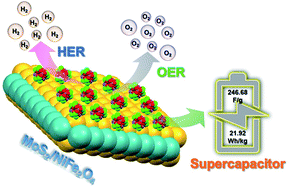Tuning the synergistic effects of MoS2 and spinel NiFe2O4 nanostructures for high performance energy storage and conversion applications†
Abstract
Proficient energy generation and storage systems are required to meet the growing energy demand with the advancement of electronic technologies and increasing human population. Two-dimensional materials such as molybdenum disulfide (MoS2) have attracted enormous attention for device applications due to their unique optoelectronic properties and layered structure. On the other hand nickel ferrite (NiFe2O4) shows adequate electrical properties and rich redox chemistry. This work is aimed to fully utilize the merits of each of these materials to achieve high specific capacitance and electrocatalytic performance. A simple hydrothermal method was developed to synthesize MoS2/NiFe2O4 nanocomposites. The symmetric MN5 (MoS2/NiFe2O4) based supercapacitor device delivered a high specific capacitance of 246.68 F g−1 at a current density of 0.5 A g−1 with a high-energy-density (21.92 W h kg−1) and high power density (17 972.10 W kg−1). The MN5 nanocomposite catalyst exhibited a lower overpotential of 125 mV for the HER (@ 10 mA cm−2) and 300 mV (@ 50 mA cm−2) for the OER, with excellent stability in alkaline electrolyte. This work signifies that the as-prepared MoS2/NiFe2O4 nanocomposite emerges as one of the attractive candidates for high-performance energy technologies.



 Please wait while we load your content...
Please wait while we load your content...